| News |
Monday, December 7, 2015, 8:33PM
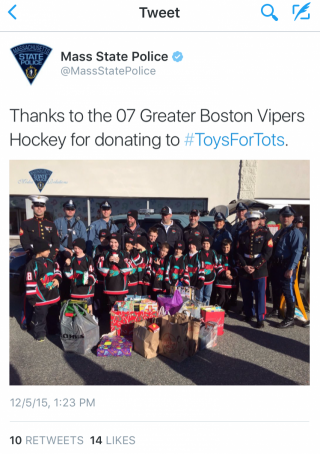 The 07A Vipers created a festive
atmosphere with holiday music, hot
cocoa, snacks, family and friends and
scored a huge goal at the Massachusetts
State Police "FILL THE CRUISER" event
held at the Woburn Toys R Us on
Saturday, December 5th. Each player
was asked to solicit at least 5 toys for
children less fortunate than them. The
team came up big and donated well over
100 toys!! They also encouraged others
entering the store to do the same with
tremendous success. The Mass State
Police recognized the 07's efforts with
postings on their Facebook page and the
Tweet pictured above.
"The Coaching staff was extremely proud
of the team's commitment to and follow
through on the event," said Coach
Cush. "The compliments from the
Marines and the Troopers about their
generosity and their polite and respectful
behavior was testament to the players’,
their parents’ and the Viper organization’s
commitment to being good citizens who
care about their community.”
Monday, November 30, 2015, 1:19PM
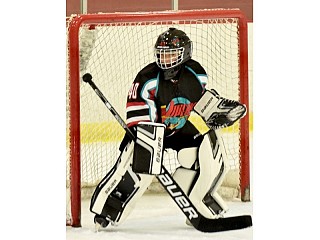 With extreme determination and grit, the 06 Greater Boston Vipers put together an incredibly strong November, going 6-1-0 in their division, 6-1-1 overall. Building on their solid foundation of fast skating, battling hard for the puck and playing a team game, they've become a formidable opponent in the EMHL.
No team goes far without a strong goalie between the pipes and Mike Murphy more than fits the bill. As one of the most athletic players on the team, “Murf†makes some acrobatic saves look easy. The team will need his focus and skill to be at a high level as they head into the meat of their schedule.
�
Standing in front of Murf are some of the steadiest defensemen in the league. With a long reach, Jimmy Driscoll provides a steady force on the blue line at right D, never giving up on a play, always sending the puck away from harm. Playing left D, Cam Sullivan tracks down the opponent's speedy forwards, makes the transition game happen and adds explosive offense when the opportunity presents itself. The Norton brothers have split time on both D and forward. Will Norton shows off his strong skating and deft hands while playing both positions. Always in the mix, making plays and setting the tone, he is an integral part of every shift. When the team needs grit and and a physical boost, Aidan Norton is there to provide one. Never afraid to go into the corners and do the dirty work, Aidan has done a stellar job, whether on the point or digging for a tough goal in front of the other teams' net. The other two players who have taken a regular shift on D are Ryan MacEachern and Nick Brandano. Ryan joined the team at the end of the summer and what an addition he has become. When the term “utility player†is used, Ryan's name comes to mind. Whether asked to play D, wing or center, MacEachern does the job with a “yes coachâ€, “I'll take care of it†attitude. The coaching staff can't ask for more than that! Nick's game begins with a strong blue line presence. Holding the opposing team deep in their zone is the key to success. Pinching in, holding the boards, forceful dump ins, are all part of Brandano's game. He contributes the same effort on forward too!
�
While a good goaltender and strong defense certainly are the back bone of a team, wins don't happen without scoring goals. The offense on this Vipers team can only be described as dangerous. Using a strong forecheck, they attack with a purpose and constant pressure. The forwards group has been on fire lately and it all starts with aggressive play deep in the offensive zone. Two players on this Vipers team are perfect examples of aggressive, tough on the puck wingers, Steve Migliero and Zac Benedetto. Benedetto takes after his policeman dad and lays down the law in the corners, using his strong body to out-muscle and extract the puck from anyone in his way. Migliero, one of the biggest and most physical players on the team, plays a similar game. Digging and doing the dirty work along the boards is not always fun but Steve seems to enjoy the battles with a smile. Dillon Reilly, a skilled winger and center, uses his speed and puck carrying ability wisely. Reilly will drive into the offensive zone with a goal in mind and either pop one in or crash the net for loose pucks. Another speedy wing, Braedon Flanagan has been steadily increasing his point total. With a high tempo motor, Flanagan is relied upon to carry the puck through the neutral zone and does a superb job of it, firing the puck on net for goals or generating rebounds. When talking about rebound goals, Brendan Heffron's name comes to mind. Playing wing, he seems to have a knack for being in the right spot at the right time. Hockey sense is a big part of his game and it guides him into the perfect position for one timer goals on a consistent basis. Heffron also plays a feisty game along the boards and in the corners.
Coming into this season, no one knew what to expect from this team. Now that they are deep into it, an identity is forming, one of hard work and and a never give up attitude. The team is becoming one, pulling for each other, sticking up for each other, eating together, practicing hard together, winning and losing games together. No player on this team can do it alone and they have come to realize this. Heading into December after an incredible November, they'll need to continue this all for one mentality to carry them through the upcoming grind. Keep an eye on this 06 Vipers team. They will be fun to watch!
Tuesday, November 24, 2015, 8:43PM
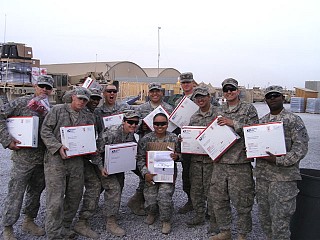 � � This holiday season the 06 AAA Viper team will be sending care packages to Soldiers who are deployed overseas. � Our hope is that each player will ask family, friends and neighbors to donate a total of 5-10 of the items on the attached list.� We will also be sending pictures and cards made by the players along with a team picture.
�
�� � Please have all donations into Trish or Mike by December 10th.� You can bring donations to any practice or game starting Saturday, November 28th.
�
�� � A few Soldiers will tentatively pick up our donation at the Family Skate on December 12th.� If we do not end up having the family skate, the Soldiers will come to one of our games to pick up the packages.
�
�� � Coach Sully will explain all of this to the boys on Wednesday (11/25) at practice.� He will also hand out envelopes with the donation requests and paper for the boys to draw �“Thank You†cards or posters to the Troops. � Thanksgiving is a great time for the boys to talk to family and friends about donating to this special cause. �
�
Please hand the pictures/cards to Trish by December 10th as well!
� �
Contact Trish with any questions!
Tuesday, November 24, 2015, 4:14PM
 The '07AAA Venom will be Proudly Supporting the Massachusetts State Police in their Annual "FILL THE CRUISER" Event for at the Woburn Toys R Us on Saturday, December 5th @ 1 p.m.
An important part of the Vipers mission is to develop fine young men and women both
on and off the ice. As part of that mission, each team is required to participate in at least
one charitable event during the season. This year our team will be supporting the Toys
for Tots charity by participating in the Massachusetts State Police "Fill the Cruiser"
event. As many of you know, our own Carly Constantine (mother of #18 Riley) is a
proud member of the Massachusetts State Police, so we thought it fitting to support her
in her efforts with Toys for Tots this year, making it a family event. To that end, we are
asking that each player solicit donations of five (5) new, unwrapped, non-violent toys for
ages newborn to 14 from family members, friends or neighbors to donate at the Fill the
Cruiser Event to be held at the Woburn Toys R Us (366 Cambridge St.) on December
5th. We will meet at 1pm in the parking lot to present our gifts as a team and take a
team picture. Asking them to gather 5 presents will give our players the opportunity to
think about the reason for Toys for Tots (see the Toys for Tots objectives below) and
give them the opportunity to make a difference through their actions. We'll also have
some hot chocolate and treats (nut-free of course) for the kids and the Mounted Police
Unit will be there to introduce the kids to the horses and take pictures. As Carly always
says, "Horses make everything much cooler."
Please let me or Carly know if you have any questions.
Leslie
Mission, Goal, and Objectives of the Toys for Tots Program
Mission: The mission of the Toys for Tots Program is to collect new, unwrapped toys
and distribute those as Christmas gifts to less fortunate children in the community where
they are collected.
Goal: The primary goal of Toys for Tots is to deliver, through a new toy at Christmas, a
message of hope to less fortunate youth that will assist them in becoming responsible,
productive patriotic citizens.
Objectives: The objectives of Toys for Tots are to help less fortunate children
throughout the United States experience the joy of Christmas; to play an active role in
the development of one of our nation's most valuable resources -- our children; to unite
all members of local communities in a common cause each year during the annual
collection and distribution campaign; and to contribute to better communities in the
future.
Monday, November 16, 2015, 2:00PM
 The 6th annual Vipers Parent Appreciation Night at Kowloon Restaurant is scheduled for: Thursday, November 19th, 2015 @ 7:00pm.
Dinner and Entertainment will be provided by the Vipers. Cash Bar. Dinner will be served at 7pm which will be followed by a Comedy Show. This is an adult-only event.
All Vipers on-ice events have been rescheduled so that everyone can all have a night away from the rinks to relax and enjoy ourselves. This event is always a lot of fun for the parents each year.
RAFFLE/AUCTION ITEMS:
Items will be 100% tax deductible. If you have:
Please email: vipers@vipersicehockey.com with more specifics.
We are working with a 501(c)3 Charity again this year with proceeds benefiting the Patrick Gill Scholarship that was started last year. As most of you know, Patrick was an overwhelming personality on the 97Vipers and his memory will continue to help Vipers families for years to come.
Thank you.
Monday, November 9, 2015, 2:29PM
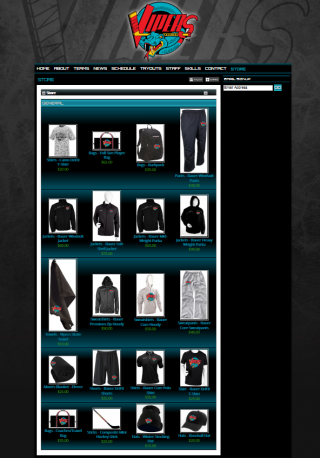 The online Apparel Store is open until 12:00 noon today.
To ensure all items arrive in time for Christmas, all sales are final as of today at noon.
This will be the final apparel order for this season.
Here is the direct link: www.vipersicehockey.com/store
All sales are final and the Vipers will not be ordering extra stock.
If you have any questions, please email: apparel@vipersicehockey.com
Monday, November 9, 2015, 12:50AM
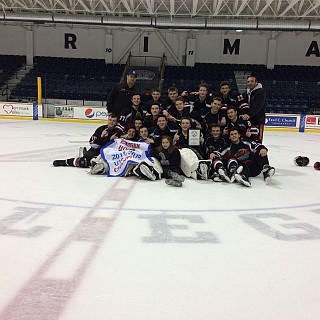 U16 Black win EHF Tier 1 Championship...........
Details to follow
Tuesday, October 20, 2015, 8:15PM
Welcome to the all new Vipers website. The site has been completely redesigned with a new sharp look.
Some new items that will be coming soon:
- The Venom Club
- Alumni Page
- 2016-17 Tryout Page
If you haven't already, connect with the Schedule iCal on your mobile devices so that you are always up-to-date with your child's schedule.
If you notice any links that are not working, please notify: vipers@vipersicehockey.com
Tuesday, October 6, 2015, 2:47PM
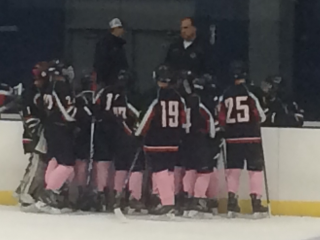 The Viper Red 2002 team unified to show support for breast cancer awareness by all wearing pink socks. They added another win on Saturday to improve thier record to 7-0 and into 1st place.
Saturday, September 5, 2015, 12:20PM
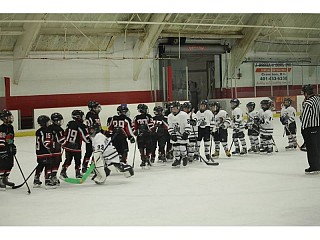 After several years of honing their skills as mites, this group of young men has come together to form the Greater Boston Vipers 06AAA Squirt team. The players bring with them unique talents and the hope is that they compliment each other to form a formidable opponent in the EMHL hockey league. All of them realize that effort, dedication and teamwork are required to succeed this season. The coaches are excited to work with this newly formed group and have no doubt that they will work hard to be competitive. Please welcome the Vipers 06AAA Squirt team: Will and Aidan Norton, Cam Sullivan, Zac Benedetto, Dillon Reilly, Nick Brandano, Ryan MacEachern, Jimmy Driscoll, Aiden Gray, Braedon Flanagan, Steve Migliero, Brendan Heffron and last but not least, goalie Mike Murphy! They kicked off their season with a strong performance today against the Providence Jr Friars. Here’s to a successful rest of the 2015-16 season!
|
|
|
















